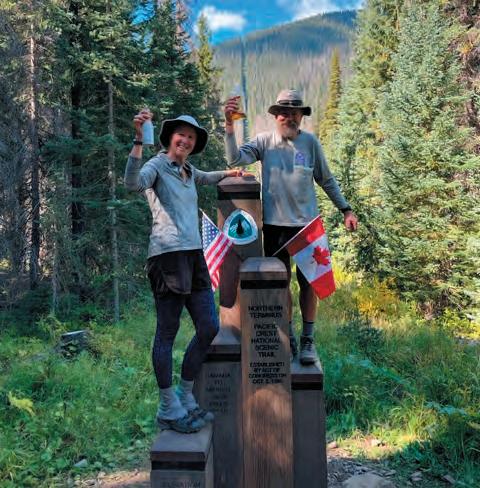
13 minute read
Joan & Larry Parker
40 Years and Then an Epic Trek
by Will Jones
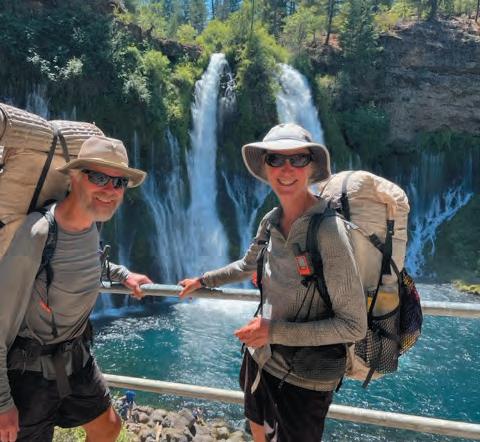
When most couples think about celebrating a milestone wedding anniversary, their ideas might range from good food and champagne at a local restaurant, a luxury weekend at a spa, or maybe even a trip to Hawaii or Europe. But not San Luis Obispo residents Joan and Larry Parker. Their idea of an appropriate celebration was to hike 2,650 adventure-filled miles on the Pacific Crest Trail from the Mexican to the Canadian border.
Larry and Joan met as undergraduates at UC Berkeley. Larry grew up in Fremont and Joan in Concord. Both were athletic and outdoors-oriented. Joan played two seasons of water polo for Berkeley. Larry was a swimmer and an Eagle Scout, and, later, a Scoutmaster.
A few months after they started dating, in February 1980, Larry took Joan on her first backpacking trip in Little Yosemite Valley. It was memorable for three reasons: a bear removing a pack Joan was using for a pillow from beneath her head while she was sleeping and neatly consuming five pounds of trail mix and a pound of salami; an ascent of Half Dome; and Larry proposing after the initial excitement was over. Joan still has the ring Larry fashioned from pine needles. Larry was 23 and Joan 22 when they married in October of 1981.
The Parkers moved from Walnut Creek to San Luis Obispo in 1993 when Larry, a mechanical engineer, was transferred to Diablo Canyon by PG&E. Joan, a financial adviser, commuted to Walnut Creek for a couple of years until she was hired by Wacker Financial Planners in 1995.
Backpacking continued to be a family activity as their sons, Scott, 34, and Eric, 31, were growing up.
“We tried to do a trip every summer,” Larry said. “To have that time on the trail with them was priceless. In the wilderness, they’d share all the things that were going through their minds, things they didn’t have time to talk about during busy lives at home.”
The second most ambitious hike the Parkers completed was section hiking the John Muir Trail during the summers from 2013-16, four separate one-week hikes covering over 200 miles.
“We actually found that more difficult than the PCT because we had to acclimatize four different times and get on and off the trail several times,” Joan said.
They also climbed Mount Kilimanjaro as a family in 2010.
Larry and Joan started thinking about hiking the Pacific Coast Trail (PCT) in 2013.
alone, thinking if they can do it alone, we can do it together,” Joan shared.
One challenge before leaving for the trip was for Joan to find a way to unwind the financial planning business she had started.
“I found a company to merge with and spent most of my time transitioning my clients while Larry was doing all of the preparation,” Joan said.
Getting a permit was also a challenge. One person can’t sign up two people, so on the day the permits became available, they were on two devices hoping to win the PCT “lottery.”
“Once you start the process, you only have 20 minutes to complete it,” Larry explained. “We didn’t get the best lottery pick, but it was close to what we wanted.”
Larry started planning and getting physically prepared in August of 2020. He read all of the maps, figured out the resupplies, determined how far to hike each day based on mileage, altitude gain, water availability, and their goal for completing the trek.
“We had family and friends (also known as Trail Angels) meet us at various points along the trail,” he said. “We only had to mail six packages to pick up ourselves.”
Committed to attending a family wedding on September 19, 2021, Joan and Larry started their hike on April 6. They entered September 16 as their exit date, which meant they had to average 16 miles per day. Achilles tendinitis slowed Joan for the first three weeks, but in the end, they completed the hike in 155 days, which included 22 rest days, averaging over 20 miles per day.
Rest days meant getting to town in the evening, spending the night, spending the next day resting and getting resupplied, and spending another night in town.
“We spent 44 nights sleeping in a bed. I was very proud of that,” Joan said.
One break included three days in Lone Pine in May, waiting out a snowstorm. Despite the rest days, Larry, whose trail name was Lar Bear, lost 25 pounds, and Joan, whose trail name was Sunshine, lost 15.
Pacific Crest Trail hikers encounter countless challenges, but Larry singled out one in particular. weeks to go,” he said. “At the top of an unnamed pass, I took my pack off, put it on a rock, the pack rolled off the rock, across ground that didn’t look like it had much slope, but it kept rolling, went between two trees, down a 30-foot cliff and out of sight. In the fog and mist, I could still hear it tumbling.
“We only had a couple of hours to search before we would have to hike to the pass and hitchhike into town to get all new gear. Plus, our wallets and passports were in it. I went down a couple of switchbacks and across a couple of slopes, hanging onto berry bushes. It was really steep. Finally, I saw my mask, which had fallen out of the only open pocket. I went directly down from there and found my pack. It had tumbled over 500 vertical feet, just
It took a while for Joan and Larry to reconnect on the trail with the help of another hiker, trail name Sausage.
“We went down a couple of switchbacks, and all of a sudden, I saw Larry’s head pop up,” Joan said.
Both agreed that the most beautiful and memorable section of the trail was getting to the top of Muir Pass.
“Hiking in snow, we got to the Muir Hut at about 4:30,” Joan said. “We started heading down Evolution Valley, the most stunning view,
Continued on Page 20
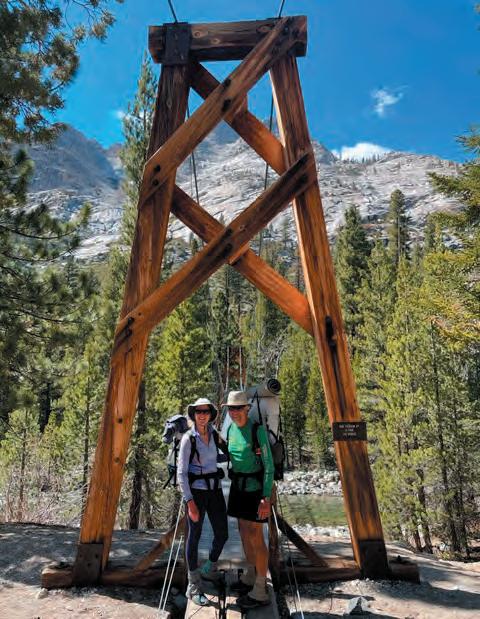
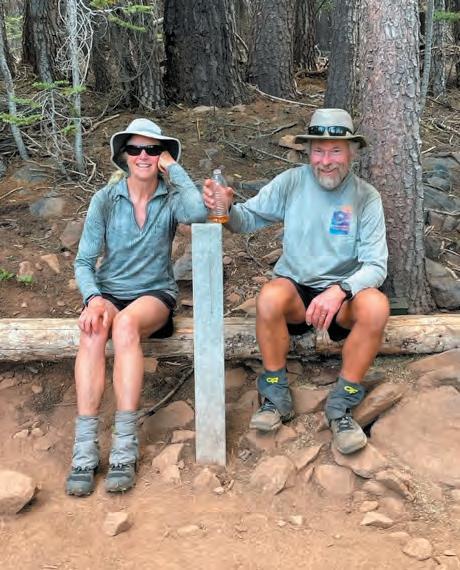
To celebrate their milestone anniversary, the two hiked 2,650 miles on the Pacific Crest Trail from the Mexican to the Canadian border. Contributed photo
It took Joan and Larry five months to hike the trail, finishing just in time for a family wedding in September 2021. Contributed photo
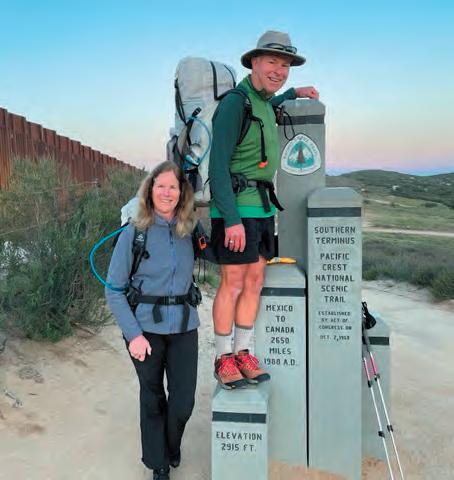
Continued from Page 19 view, covered with snow. We were post-holing up to our hips, soaking wet, cold, but so beautiful. It’s like being let into Yosemite, and you’re all alone.”
Finishing at the Canadian border was also an exciting time. They were frustrated because they couldn’t get into Canada due to COVID. They had to hike 30 miles back to Hart’s Pass in northern Washington, the closest place a car could get to.
“We got to see a lot of people we’d already seen on the trail who were approaching the finish, to share stories, exchange phone numbers, and share the excitement,” Larry said.
“The trail is so simple,” Joan said. “You know what you’re doing every day: hiking, eating, sleeping. We really enjoyed the vagabond lifestyle, sleeping somewhere new every night. We were like an orchestra, knowing each other’s moves, setting up camp, packing up in the morning.”
A lasting memory for Larry and Joan is the determination of their fellow hikers: moving forward with problems like a broken rib, or navigating difficult creek crossings with precarious snow bridges. Also memorable is all the trail angels who met them along the way, including their sons.
Once they reached Seattle, after coming off the trail, they indulged in haircuts, massages, and new clothes. Ironically, Larry said, “The transfer van dropped us off two miles from our hotel, so of course, we walked with our packs.”
At the end of our interview, Larry said, “Hiking together was both a blessing and a curse. It wouldn’t be worth doing it by myself. But being together increased the odds of one of us getting hurt and forcing us off the trail.”
But, Joan said, “We didn’t want to let the each other down. We wanted to help and motivate each other, make sure we could make it.”
Maybe five months on the trail together is the perfect metaphor for a successful 40-year marriage. But you will have to ask Joan and Larry. You can find them hiking the trails in the county, still as enthusiastic about hiking as when a bear enjoyed Joan’s lunch on that first backpacking trip over 40 years ago.
TASTE OF AMERICANA:
Valentine’s Day Full of Homemade Sweets
by Barbie Butz
February is a special month. We celebrate the birthdays of Washington and Lincoln with President’s Day on the 15th. But, don’t forget that on the 14th, it’s time to celebrate the “sweet” people in our lives who love us and support us. Traditionally, we celebrate by sending Valentine greeting cards, bouquets of flowers, chocolates, and other sweets.
Nothing says, “I love you” better than a homemade dessert. So here’s a recipe that is certain to please all of your “special” people.
Ingredients For the cake:
• 2 cups fresh raspberries • ¾ cup plus 2 tablespoons granulated sugar, divided • 2 tablespoons water • 2 1/3 cups all-purpose flour • 1/3 cup cocoa powder • 1 teaspoon kosher salt • 1 teaspoon baking soda • 1 cup (2 sticks) unsalted butter, room temperature • 1 cup brown sugar • 3 eggs, room temperature • 4 ounces unsweetened chocolate, melted • ¾ cup plain Greek yogurt or sour cream

For the compote:
• 1 large orange • 3 tablespoons brown sugar • 2 tablespoons honey • 1 teaspoon orange zest • ¼ teaspoon kosher salt • 4 cups fresh raspberries • 2 tablespoons Grand
Marnier or other orange liqueur T o make the cake, combine the raspberries, 2 tablespoons of the granulated sugar, and water in a medium saucepan and bring to a boil. Reduce the heat to a simmer, and cook the raspberries until they break down into a sauce. Push the raspberry pulp and juice through a fine-mesh strainer. Cool the puree to room temperature or chill before using.
Preheat the oven to 350 degrees. Lightly grease the bottom of a round 10-inch cake pan and line with a circle of parchment paper. Do not grease the sides of the pan. (this cake releases easily from the sides, and greasing the sides means the cake doesn’t have anything to hold on to while it rises during baking.
Sift the flour, cocoa powder, salt, and baking soda in a medium bowl.
In the bowl of a stand mixer fitted with the paddle attachment, cream the butter, brown sugar, and ¾ cup of granulated sugar on medium speed until light and fluffy (about 5 minutes), scraping once. Add the eggs one at a time, scraping well after each addition. Mix in the melted chocolate.
Combine the yogurt and raspberry puree in a medium bowl and set aside. With the mixer on low speed, mix half the dry ingredients into the butter mixture until almost combined. With the mixer running, add the raspberry mixture. Then mix in the remaining dry ingredients until almost combined. Scrape the bowl again and mix an additional 30 seconds on low speed until the batter is smooth.
Spoon the batter into the prepared pan. Bake the cake for 40 to 45 minutes or until the top springs back when touched. Cool to barely warm before removing the cake from the pan. Cool the cake completely before serving.
To make the compote, peel the orange and clean off the white pith and webbing. Cut the segments into 1/2-inch pieces (about 1 cup). Combine the orange pieces, brown sugar, honey, zest, and salt in a medium pot and bring to a simmer over medium-high heat. Reduce the heat to medium-low and continue to simmer for about 5 minutes. Stir in the raspberries and the Grand Marnier. Cover and refrigerate the compote overnight.
If you’ve made the compote the day before, about 2 hours before serving, remove the compote from the refrigerator. Cut the cake into wedges, and serve the compote alongside the cake. Hold leftover cake covered at room temperature and put the compote in the refrigerator for up to 2 days.
This recipe is sure to please chocolate lovers. It’s just one tall, super moist layer.
Happy Valentine’s Day. Enjoy!

CALIFORNIA:
The Great Cannabis Debate
by Camille DeVaul
One of the most controversial topics currently discussed on the Central Coast seems to be the cultivation, use, and distribution of cannabis.
Before discussing various viewpoints of the topic, we first need to know the background and timeline for the legalization of cannabis in California.
In 1913, California was one of the first to ban marijuana but decriminalized the substance in 1975.
Then, in 1996 California was the first state to legalize medicinal marijuana with Proposition 215, which “allowed qualified patients and approved caregivers to possess and cultivate medical cannabis and ultimately led to the formation of collectives and cooperatives to serve medical patients throughout the state.”

Three bills were passed in the Medical Cannabis Regulation and Safety Act (MCRSA) which “created a state licensing and regulatory system for the existing medical market. MCRSA also established the state’s three cannabis licensing authorities – (Bureau of Cannabis Control, CalCannabis Cultivation Licensing, and Manufactured Cannabis Safety Branch).”
However, these bills were repealed in 2017 when California State Legislature passed Senate Bill 94. This bill combined MCRSA with the Adult-use Marijuana Act (AUMA) to create the Medicinal and Adult-Use
Cannabis Regulation and Safety Act (MAUCRSA), “a single regulatory system governs the medicinal and adult-use cannabis industry in California.”
In November 2016, California voters approved Proposition 64, which allows “adults 21 years of age or older can legally grow, possess, and use cannabis for non-medicinal purposes, with certain restrictions. Additionally, AUMA also made it legal to sell and distribute cannabis through a regulated business as of January 1, 2018.”
Although the use, distribution, and cultivation of cannabis are now legal in California, MAUCRSA establishes a dual licensing structure where both state and local governments have guidelines. This means the state sets minimum requirements that all licensees must follow, and local governments can set additional requirements.
Within SLO County, you have varying rules on the use and distribution of cannabis in each city or territory of the county.
Paso Robles City Limits Rules:
Cannabis Dispensaries: Dispensaries with storefronts open to the public are prohibited. Delivery dispensaries are limited to medical-only dispensaries (mobile deliveries).
Commercial Cannabis Cultivation: Commercial cannabis cultivation, indoor and outdoor, is prohibited.
Personal Cannabis Cultivation: Six cannabis plants total, grown indoors, per dwelling unit, for personal use, are permitted. Outdoor personal cultivation is prohibited.
Cannabis Activities: Cannabis testing facilities are prohibited. Cannabis manufacturing facilities are prohibited.
Atascadero City Limits Rules:
Cannabis Dispensaries: Dispensaries with storefronts open to the public are prohibited. Deliveries of recreational and medical cannabis are permitted when the dispensary is located outside of City limits.
Commercial Cannabis Cultivation: Commercial cannabis cultivation, indoor and outdoor, is prohibited.
Personal Cannabis Cultivation: Six cannabis plants total, per dwelling unit, for personal use, are permitted. Outdoor and indoor personal cultivation is permitted.
Cannabis Activities: Cannabis testing facilities are permitted. Cannabis manufacturing facilities are prohibited.
As for unincorporated areas of the county, the County Board of Supervisors set cannabis-related policies.
Unincorporated areas in SLO County include:









